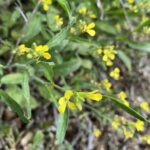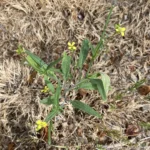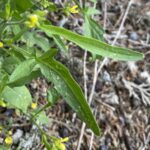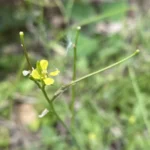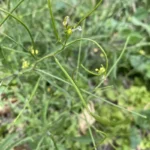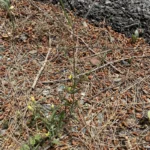Σισύμβριο το ανατολικό
Etymology of Sisymbrium orientale
The name of the genus, "Sisymbrium", derives from the Ancient Greek "σισύμβριον" [sisymvrio], which was the word used for this plant. It also means "woman's jewel", but it is of unknown etymology. The name "orientale" is derived from the Latin word "orientalis," which means "eastern" or "of the east." This epithet was likely given to the species by Carl Linnaeus because he considered its origin to be in the East, specifically the Mediterranean region and Western Asia. So, Sisymbrium orientale literally translates to "eastern Sisymbrium."
The Sisymbrium genus in Cyprus
There are six Sisymbrium taxa found in the wild Cypriot habitat.
The habitat of Sisymbrium orientale
Sisymbrium orientale, or Indian hedgemustard, has a broad native distribution encompassing Europe, Asia, and North Africa. However, due to its adaptability and prolific seed production, it has successfully established itself as an introduced species in many other temperate regions worldwide. This includes significant parts of North and South America, Australia, and various islands. It is frequently encountered as a common weed in these introduced areas, thriving in disturbed habitats and often outcompeting native vegetation. Its widespread distribution highlights its ability to tolerate a range of environmental conditions and readily colonize new territories following human activity.
In terms of habitat, Sisymbrium orientale is typically found in anthropogenic (human-influenced) environments. This includes roadsides, agricultural fields, waste areas, disturbed ground, and even cracks in pavements in urban settings. It demonstrates a preference for well-drained soils and can tolerate a range of soil types, from sandy to loamy. While it can grow in both sunny and partially shaded locations, it often flourishes in open, sunny areas. Its ability to thrive in disturbed habitats contributes to its success as an introduced and sometimes invasive species, as it readily colonizes areas where natural vegetation has been cleared or altered.
The plant in Cyprus
Sisymbrium orientale is a relatively common plant encountered mostly in the southern half of Cyprus, up to an altitude of 1650 metres. Its flowering period is between April and August.
Key characteristics of Sisymbrium orientale
Identifying Sisymbrium orientale among its relatives in the Sisymbrium genus hinges on a few readily observable features. These key characteristics, focusing on the plant's overall size, the unique structure of its leaves, and the distinct morphology of its fruiting siliques, provide a reliable means of distinguishing this common and often widespread species.
Height
Sisymbrium orientale typically stands taller than many other Sisymbrium species, often reaching a mature height ranging from 30 centimeters to 1 meter, and sometimes even exceeding this. This relatively robust stature, especially when fully grown and in fruit, can be a primary indicator distinguishing it from smaller, more low-lying members of the genus. While some other Sisymbrium species can also achieve considerable height, the combination of this with other features helps in accurate identification.
Leaf Morphology
The leaves of Sisymbrium orientale exhibit a distinct pattern of lobing. The basal and lower stem leaves are typically pinnately lobed or divided, characterized by a larger terminal lobe at the tip and several smaller lateral lobes arranged along the leaf axis, decreasing in size towards the base. As one moves up the stem, the upper leaves often become less divided, transitioning to a more lanceolate (lance-saped) form or having fewer lobes. This variation in leaf morphology along the stem is a useful characteristic for recognizing this species.
Fruiting Siliques
The developed fruit, a silique, offers significant clues for identification. In Sisymbrium orientale, the siliques are characteristically long and slender, often appearing somewhat linear and ranging from 4 to 10 centimeters in length. These siliques are typically held somewhat spreading or ascending on pedicels (fruit stalks) that are also relatively long, often measuring a centimeter or more. A notable feature is that the siliques are usually longer than their supporting pedicels and can exhibit a slight curvature. This combination of long, thin, spreading siliques on relatively long stalks is a key trait that sets Sisymbrium orientale apart from other species in the genus, which may have shorter, more erect, or differently shaped siliques.
The habitat of Sisymbrium orientale
Sisymbrium orientale, or Indian hedgemustard, has a broad native distribution encompassing Europe, Asia, and North Africa. However, due to its adaptability and prolific seed production, it has successfully established itself as an introduced species in many other temperate regions worldwide. This includes significant parts of North and South America, Australia, and various islands. It is frequently encountered as a common weed in these introduced areas, thriving in disturbed habitats and often outcompeting native vegetation. Its widespread distribution highlights its ability to tolerate a range of environmental conditions and readily colonize new territories following human activity.
In terms of habitat, Sisymbrium orientale is typically found in anthropogenic (human-influenced) environments. This includes roadsides, agricultural fields, waste areas, disturbed ground, and even cracks in pavements in urban settings. It demonstrates a preference for well-drained soils and can tolerate a range of soil types, from sandy to loamy. While it can grow in both sunny and partially shaded locations, it often flourishes in open, sunny areas. Its ability to thrive in disturbed habitats contributes to its success as an introduced and sometimes invasive species, as it readily colonizes areas where natural vegetation has been cleared or altered.
The plant in Cyprus
Sisymbrium orientale is a relatively common plant encountered mostly in the southern half of Cyprus, up to an altitude of 1650 metres. Its flowering period is between April and August.

